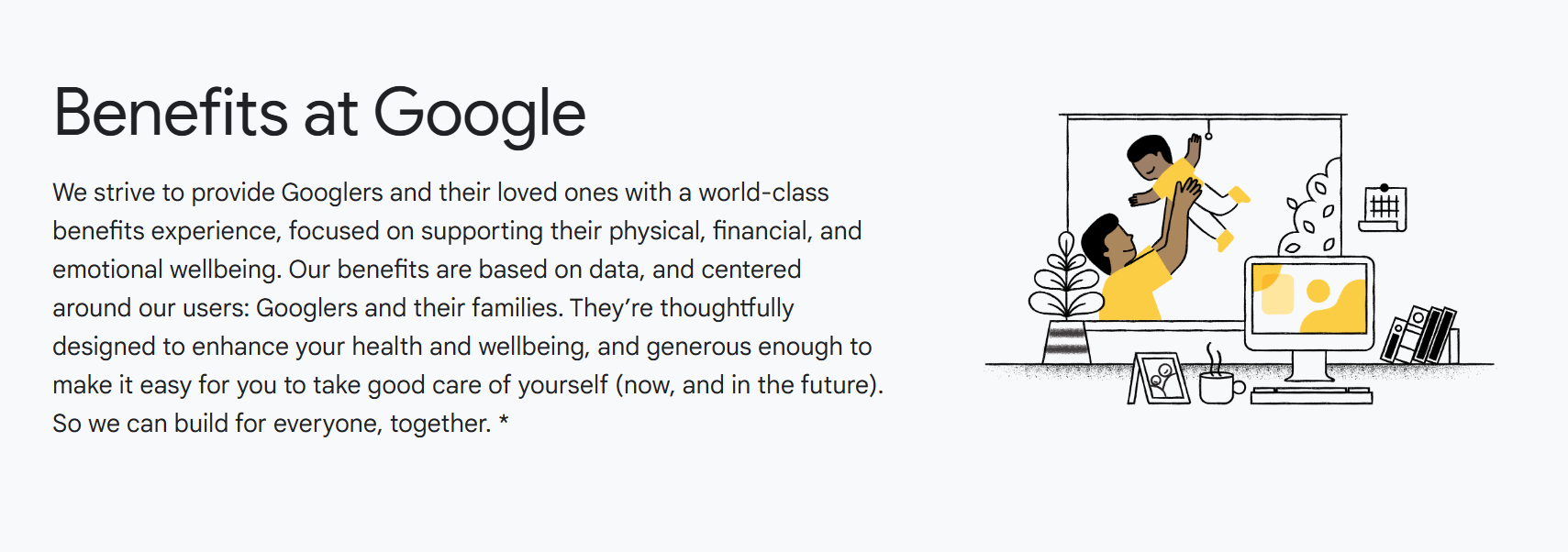Umfassender Leitfaden zu den besten Optionen für Mitarbeitervorteile im Jahr 2025
Die Optionen für Leistungen an Arbeitnehmer umfassen wichtige Arten und bewährte Verfahren für die Zusammenstellung eines wettbewerbsfähigen Pakets.
Auf dieser Seite
- Verständnis für die Vorteile des Arbeitnehmers
- Arten von Leistungen
- Die Auswirkung von Optionen auf die Sozialleistungen
- Beispiele für führende Unternehmen
- Wege zur Verbesserung der Mitarbeiterzufriedenheit
- Die wichtigsten Vergünstigungen, die jeder Personalverantwortliche kennen sollte
- Bewährte Praktiken für Ihre Mitarbeitervorteile:
- Gesetzlich vorgeschriebene Leistungen:
- Fallanalyse: Optionen für Sozialleistungen bei Drizly
- Schlussfolgerung
- Einpacken
- FAQ's
Leistungspakete für Mitarbeiter sind heute wichtiger denn je auf dem unübersichtlichen Terrain des heutigen Arbeitsmarktes. Nur die Unternehmen, die es verstehen, diesen mächtigen Ansatz zu ihrem Vorteil zu nutzen, indem sie umfassende Sachleistungen anbieten, können sich auf dem Markt gut behaupten, wenn es darum geht, qualifizierte Mitarbeiter zu gewinnen und zu halten.
A Glassdoor 2023 ergab, dass Jobsuchende, basierend auf der Meinung von über 1.100 erwachsenen US-Amerikanern, bei der Prüfung von Stellenangeboten in der Tat Wert auf Sozialleistungen legen. Dieser Trend unterstreicht die entscheidende Rolle, die eine gute Strukturierung von Leistungspaketen für die Attraktivität eines Unternehmens für potenzielle und aktuelle Mitarbeiter spielt.
Nehmen Sie das Beispiel eines führenden Technologieunternehmens, das durch die Einführung von Gleitzeit für seine Mitarbeiter, die Möglichkeit, von zu Hause aus zu arbeiten, und weitaus bessere Gesundheitsleistungen den gesamten Ansatz zur Umsetzung von Sozialleistungen geändert hat.
Neben dem deutlichen Rückgang der Fluktuationsrate führte der neu eingeführte Plan zu einem verblüffenden Ergebnis, nämlich zu einer Steigerung der Mitarbeiterzufriedenheit um 25 % bei der Mitarbeiterzufriedenheit. Dies wäre also ein sehr guter Weg, um den Mitarbeitern das Gefühl zu geben, dass sie mit diesem neuen Leistungspaket gut versorgt sind, was das Engagement der Mitarbeiter und damit ihre Bindung an das Unternehmen verbessern würde.
In diesem umfassenden Leitfaden befassen wir uns mit den besten verfügbaren Optionen in Bezug auf Employee Benefits Options im Jahr 2024, den verschiedenen Arten und der Bedeutung sowie mit Best Practices für die Gestaltung eines Leistungspakets, das den Bedürfnissen der Mitarbeiter entspricht.
Verständnis für die Vorteile des Arbeitnehmers
Die Optionen der Employee Benefits ergänzen das reguläre Vergütungspaket, das die Mitarbeiter erhalten, und sind Teil der Lohnnebenleistungen, die den Mitarbeitern gewährt werden. Diese Leistungen verbessern das allgemeine Wohlergehen der Mitarbeiter, was wiederum hauptsächlich zur Arbeitszufriedenheit beiträgt; daher sind diese Leistungen sehr wichtig für die Entwicklung der Organisationskultur und geben den Mitarbeitern das Gefühl, dass sie wichtig sind und dass für sie gesorgt wird.
Ein gutes Sozialleistungspaket deckt alle Bedürfnisse der Mitarbeiter in Bezug auf Gesundheit, finanzielle Sicherheit und Work-Life-Balance ab, bringt aber auch das Interesse des Unternehmens an ihrem Wohlergehen zum Ausdruck. Darüber hinaus trägt es zu einer freundlichen Arbeitsatmosphäre bei und verbessert die Moral der Mitarbeiter im Allgemeinen.
Arten von Leistungen
Es gibt verschiedene Arten von Sozialleistungen, die den Arbeitnehmern rund um den Globus gewährt werden.
- Krankenversicherung: Dies ist wohl die wichtigste Voraussetzung für ein gutes Leistungspaket. Sie sichert das Personal gegen alle Arten von medizinischen Einrichtungen und Vergütungen für die Teilnahme an verschiedenen Gesundheitsdiensten ab. Dazu gehört eine umfassende Krankenversicherung, die Arztbesuche, Krankenhausaufenthalte, die Kosten für verschreibungspflichtige Medikamente und Präventivmaßnahmen abdeckt.
- Bezahlte Freizeit (PTO): Zu den PTOs gehören Urlaubstage, Krankheitsurlaub und persönliche Tage. Je großzügiger die Richtlinien für bezahlte Freizeit sind, desto besser können die Mitarbeiter ein Gleichgewicht zwischen Arbeit und Privatleben herstellen und verhindern, dass Burnout in Arbeitszufriedenheit umschlägt.
- Ruhestandsplan: Im Grunde handelt es sich dabei um den Ruhestandsplan - 401(k) oder Pensionsplan -, durch den ein Arbeitnehmer während der Dienstjahre finanzielle Sicherheit erhält, aber nicht während seiner Dienstzeit. Der Arbeitgeber kann diesen Plan noch verlockender machen, indem er das Gefühl des langfristigen finanziellen Wohlergehens für die Arbeitnehmer noch weiter steigert.
- Wellness-Programme: Solche Programme helfen einem körperlich und geistig behinderten Mitarbeiter, ein gutes Leben und einen gesunden Lebensstil zu führen. Zu den Vorteilen gehören kostenlose Mitgliedschaften in Fitnessstudios, Wellness-Herausforderungen, Ressourcen für die psychische Gesundheit oder die Möglichkeit, einen Berater für Gespräche zu bekommen.
- Flexible Arbeitsstrukturen: Telearbeit, komprimierte Arbeitszeiten und flexible Arbeitszeiten verwischen die Grenzen zwischen Beruf und Privatleben, indem sie es den Arbeitnehmern ermöglichen, ihre Arbeit effektiv zu erledigen und gleichzeitig ein höheres Maß an Integration von Beruf und Privatleben zu gewährleisten. Solche Maßnahmen erhöhen die Arbeitszufriedenheit und die Produktivität.
- Berufliche Entwicklung: Dazu können ein Bildungsstipendium, Mentorenprogramme und Schulungsmöglichkeiten gehören. All dies fördert die berufliche Entwicklung und zeigt, dass der Arbeitgeber in die Entwicklung seiner Mitarbeiter investiert, wodurch diese zufriedener werden und eher im Unternehmen bleiben.
Die Auswirkung von Optionen auf die Sozialleistungen
Die Zusammenlegung von Leistungen wirkt sich auf folgende Weise direkt auf die Psyche der Arbeitnehmer aus:
- Anwerbung und Bindung: Sozialleistungen spielen eine große Rolle bei der Gewinnung der besten Talente. Attraktive Leistungspakete verschaffen Ihrem Unternehmen einen Vorteil gegenüber konkurrierenden Arbeitgebern und machen das Unternehmen für potenzielle Mitarbeiter noch attraktiver.
So werden beispielsweise Unternehmen, die umfassende Gesundheitsleistungen in Verbindung mit Arbeitsoptionen bieten, die Flexibilität und berufliche Weiterentwicklung ermöglichen, von Arbeitssuchenden gegenüber anderen Unternehmen bevorzugt.
Darüber hinaus führen wirksame Leistungspakete zu höheren Bindungsquoten, da sie Arbeitszufriedenheit und Loyalität schaffen. Die Arbeitnehmer werden nicht so leicht abwandern und sich anderswo nach anderen Möglichkeiten umsehen, wenn sie das Gefühl haben, dass ihre Bedürfnisse erfüllt werden und ihr Beitrag hoch geschätzt wird. - Auswirkungen auf Zufriedenheit und Produktivität: Der Zusammenhang zwischen Leistungsoptionen und Arbeitszufriedenheit ist sehr gut dokumentiert. Arbeitnehmer, die Zugang zu sehr soliden Leistungspaketen haben, zeigen in der Regel ein höheres Maß an Zufriedenheit und Engagement.
Im Folgenden erfahren Sie, wie führende Unternehmen die Vorteile nutzen, um die Zufriedenheit und das Engagement ihrer Mitarbeiter zu steigern.
Beispiele für führende Unternehmen
Hier finden Sie Beispiele für führende Unternehmen, die sich im Bereich der Sozialleistungen hervorgetan haben.
1. Netflix
Bei Netflix, wird ein komplettes Paket angeboten, von der Krankenversicherung bis zur Unterstützung der psychischen Gesundheit und einem umfassenden Elternurlaub. Aus diesem Grund sorgen die ganzheitlichen Ansätze für eine hohe Mitarbeiterzufriedenheit und helfen, die besten Talente zu halten.

2. Microsoft

Microsoft wird folgende Punkte berücksichtigen flexible Arbeitsmöglichkeiten die es den Mitarbeitern ermöglichen, ihre Arbeitszeiten optimal an ihre Lebensumstände anzupassen, was ihre Zufriedenheit mit ihrer Arbeit erhöht und zu einer gesteigerten Produktivität führt.
3. LinkedIn

Dies geschieht durch Bildungsstipendien, Mentorenprogramme und Karriereworkshops bei LinkedIn. Diese berufliche Entwicklung führt nicht nur zu besseren Mitarbeitern, sondern erhöht auch die Arbeitszufriedenheit.
4. Google

Google bietet eine sehr gute Altersvorsorge, indem es seinen Mitarbeiter 401(k) und Finanzplanungsressourcen zur Verfügung stellt, damit sie sich in Bezug auf die Zukunft nicht unsicher fühlen, was wiederum ihre Loyalität und langfristige Zufriedenheit erhöht.
5. Salesforce

Salesforce: Salesforce legt großen Wert auf eine ausgewogene Work-Life-Balance und bietet daher einige Vorteile wie bezahlte ehrenamtliche Arbeit, Kostenerstattung für Wellness und eine sehr entgegenkommende Elternurlaubspolitik. All dies kann die Qualität der Arbeitsatmosphäre verbessern und die Zufriedenheit steigern.
Wege zur Verbesserung der Mitarbeiterzufriedenheit
Die wichtigsten Optionen für Leistungen für Arbeitnehmer zur Verbesserung der Mitarbeiterzufriedenheit und der besten Praktiken im Personalwesen:
- Krankenversicherung: Eine gute Gesundheit der Arbeitnehmer ist ohne eine umfassende Krankenversicherung nicht möglich. In dieser Kategorie gibt es verschiedene Pläne mit mehreren Optionen, darunter PPOs, HMOs und Gesundheitspläne mit hoher Selbstbeteiligung. Das Angebot einer Mischung aus diesen Plänen soll jedem Mitarbeiter die Möglichkeit geben, zu entscheiden, welcher Plan für seine Bedürfnisse am besten geeignet ist.
- Langfristige Ruhestandspläne: Durch solide Altersversorgungsleistungen wie 401(k)-Pläne, die vom Arbeitgeber mitfinanziert werden, Rentenpläne und die Verfügbarkeit von Finanzplanungsressourcen wird dem Arbeitnehmer ein Gefühl der finanziellen Sicherheit vermittelt, das langfristig zur Zufriedenheit am Arbeitsplatz führt.
- Wellness-Programme: Durch verschiedene Aktivitäten tragen die Wellness-Programme zur Förderung des körperlichen und geistigen Wohlbefindens bei, indem sie Dienstleistungen im Zusammenhang mit der Mitgliedschaft im Fitnessstudio, Wellness-Herausforderungen, Ressourcen für die geistige Gesundheit und Beratungsprogramme anbieten.
- Flexible Arbeitsregelungen: Mit flexiblen Arbeitsalternativen wie Telearbeit, Gleitzeit und komprimierter Wochenarbeitszeit kann ein Arbeitnehmer Fragen der Work-Life-Balance effektiver angehen, was die Arbeitszufriedenheit erhöht.
- Relevanz: Alle Arten von Leistungen sind ein Mittel, um die Zufriedenheit der Mitarbeiter zu erhöhen und die besten Praktiken im Bereich der Humanressourcen zu unterstützen. Krankenversicherungen ermöglichen den Zugang zu notwendiger medizinischer Versorgung, Altersvorsorgepläne sichern die Finanzen des Arbeitnehmers für die Zukunft, Wellness-Programme verbessern den allgemeinen Gesundheitszustand und flexible Arbeitsregelungen ermöglichen es den Arbeitnehmern, ihr Privat- und Berufsleben in Einklang zu bringen.
Die wichtigsten Vergünstigungen, die jeder Personalverantwortliche kennen sollte
Nachfolgend sind einige wichtige Vergünstigungen aufgeführt, die inbegriffen sein können:
- Bildungsstipendien: Bildungs- und Weiterbildungsstipendien werden den Mitarbeitern für Aktivitäten gewährt, die ihre berufliche Laufbahn fördern. Diese Leistung ist ein Beispiel für die Investition eines Unternehmens in das Wachstum und die Entwicklung seiner Mitarbeiter.
- Zuschüsse für Fernarbeit: Zur Erleichterung der Telearbeit werden Zuschüsse für die Ausstattung des Heimbüros und die Erstattung der Internetkosten gewährt, wobei darauf geachtet wird, dass alle Telearbeiter gut mit den richtigen Materialien ausgestattet sind, um ihre Aufgaben effektiv zu erfüllen.
- Wellness-Erstattungen: Gebühren für die Mitgliedschaft in einem Fitnessstudio, Sportkurse und andere Programme oder Dienstleistungen könnten erstattet werden, um den Mitarbeitern Anreize zu bieten, sich um ihre Gesundheit und ihr Wohlbefinden zu kümmern.
- Maßgeschneiderte Leistungen: Bieten Sie ein Menü von Leistungen an, bei dem jeder Mitarbeiter aus Optionen wie einem Ausgabekonto oder einem Gesundheitssparkonto wählen kann, um sicherzustellen, dass das Leistungspaket den individuellen Bedürfnissen und Präferenzen entspricht.
Bewährte Praktiken für Ihre Mitarbeitervorteile:
Im Folgenden werden die Möglichkeiten zur Steigerung der Mitarbeiterzufriedenheit beschrieben:
- Integrationsfähigkeit und Flexibilität: Angesichts der vielfältigen Bedürfnisse der heutigen Arbeitnehmer sollte dies bei der Gestaltung von Leistungspaketen berücksichtigt werden. Ein Portfolio von Leistungsoptionen stellt sicher, dass das Leistungspaket auf die unterschiedlichen Bedürfnisse der Mitarbeiter eingeht, wie z. B. flexible Arbeitsregelungen und individuelle Anpassung der Leistungen.
- Ausrichtung auf die Unternehmenswerte: Legen Sie das Leistungspaket für das Unternehmen im Hinblick auf Werte und Kultur fest. Ein Unternehmen, in dem das Wohlbefinden der Mitarbeiter an erster Stelle steht, kann beispielsweise angemessene Wellness-Einrichtungen in das Wellness-Paket des Unternehmens aufnehmen.
- Regelmäßige Überprüfung und Aktualisierung: Jede planmäßige Überprüfung Ihres Leistungspakets ist wichtig, um wettbewerbsfähig und relevant zu bleiben. Verfolgen Sie das Feedback Ihrer Mitarbeiter und die aktuellen Trends in Ihrem Unternehmen, um sicherzustellen, dass Sie mit den Veränderungen in der Branche Schritt halten.
- Kommunikation: Vermitteln Sie den derzeitigen Mitarbeitern das Leistungspaket durch Handbücher, Informationsveranstaltungen und den Einsatz von Informationstechnologie. Es sollten Gegenkontrollen durchgeführt werden, um sicherzustellen, dass die Mitarbeiter die ihnen zur Verfügung stehenden Optionen wirklich verstehen und wissen, wie sie diese nutzen können.
- Kontinuierliche Weiterbildung: Informieren Sie Ihre Mitarbeiter über das Leistungspaket bei Änderungen oder aktualisierten Plänen. Informieren Sie die Mitarbeiter regelmäßig über neue Angebote und wie sie davon profitieren können.
- Feedback-Mechanismen: Richten Sie ein System für die Rückmeldung der Mitarbeiter ein, was sie über das Leistungspaket denken. Nutzen Sie dieses Feedback, um die notwendigen Verbesserungen vorzunehmen und etwaige Bedenken auszuräumen.
Gesetzlich vorgeschriebene Leistungen:
Nachfolgend finden Sie die bewährten Verfahren der Personalabteilung für die Einhaltung der Vorschriften für Leistungen an Arbeitnehmer:
- Krankenversicherung: Vollzeitbeschäftigte und ihre Familienangehörigen müssen gemäß dem United States Affordable Care Act versichert sein.
- Ruhestandsleistungen: Ein Arbeitgeber erfüllt die gesetzlichen Anforderungen an die Altersversorgung, indem er einen geeigneten 401(k)-Plan mit Hilfe von zweckgebundenen Arbeitgeberbeiträgen verwaltet.
- Bezahlter Krankenstand: In den meisten Ländern gibt es ein Gesetz, das die Arbeitgeber verpflichtet, bezahlten Krankenurlaub zu gewähren.
- Örtliche Vorschriften: Vergewissern Sie sich, dass Ihr Sozialleistungspaket eine Lohnfortzahlung im Krankheitsfall enthält, die den örtlichen Vorschriften entspricht.
- Familienurlaub: Arbeitgeber in den Vereinigten Staaten müssen gemäß dem Family and Medical Leave Act Urlaub aus familiären Gründen oder anderen berechtigten medizinischen Gründen gewähren.
Einhaltung der Vorschriften
- Regelmäßige Audits: Führen Sie regelmäßig Audits des Leistungspakets durch, um sicherzustellen, dass das Unternehmen alle rechtlichen Anforderungen erfüllt. Verfolgen Sie die sich ändernden Gesetze und Vorschriften und berücksichtigen Sie alle Änderungen in Ihrem Leistungsprogramm.
- Dokumentation: Leistungsangebote und Maßnahmen zur Einhaltung der Vorschriften sollten sehr gut dokumentiert werden. Eine solche Dokumentation kann die Organisation vor rechtlichen Anfragen oder Prüfungen schützen.
- Konsultation mit Experten: Durch die Zusammenarbeit mit Rechts- und Personalexperten wird sichergestellt, dass Ihr Leistungspaket nicht nur alle gesetzlichen Anforderungen erfüllt, sondern darüber hinaus auch bewährte Verfahren einbezieht.
Fallanalyse: Optionen für Sozialleistungen bei Drizly
Dieses schnell wachsende und florierende High-Tech-Unternehmen muss ein ausreichendes Paket an Leistungen für die Mitarbeiter aufbauen und erweitern, um mit der wachsenden Belegschaft und den veränderten Bedürfnissen der Mitarbeiter Schritt zu halten.
Drizly ist ein Online-Lieferservice für alkoholische Getränke und stand vor der Aufgabe, sein Angebot an Sozialleistungen so zu gestalten, dass es umfassend ist und sich an die Kapazitäten im Büro und an entfernten Standorten anpassen lässt, und gleichzeitig ein positives und unterstützendes Arbeitsumfeld zu schaffen.
Gestellte Herausforderungen
- Anpassung an das Wachstum: Ein großer Teil des Wachstums war mit erheblichen Veränderungen verbunden, vor allem in Bezug auf die Größe und Struktur der Belegschaft von Drizly. Das Unternehmen befand sich in der Wachstumsphase und musste seinen Sozialleistungsplan aufgrund der sprunghaft angestiegenen Mitarbeiterzahl, die sich zudem immer mehr diversifizierte, überarbeiten und erweitern. Die Herausforderung bestand darin, ein Leistungsprogramm zu entwickeln, das die besten Mitarbeiter anzieht und hält und gleichzeitig mit den Zielen und Werten des Unternehmens in Einklang steht.
- Unterschiedliche Bedürfnisse ausgleichen: Auf der einen Seite besteht die Belegschaft von Drizly aus einer Mischung aus Mitarbeitern im Büro und Mitarbeitern im Außendienst, die jeweils unterschiedliche Bedürfnisse und Vorlieben haben; auf der anderen Seite standen die Leistungen. Die Herausforderung bestand darin, Leistungen zu entwerfen, die für beide Gruppen von Mitarbeitern, die im Büro und die im Außendienst tätigen, von Wert und Relevanz sind. Dieses Gleichgewicht erforderte einen durchdachten Ansatz, um sicherzustellen, dass die Leistungen für Mitarbeiter im Außendienst und für Mitarbeiter im Innendienst gleichwertig und integrativ sind.
Umgesetzte Lösungen
Drizly hat die Herausforderungen des Wachstums erkannt und ein verbessertes Leistungspaket mit wichtigen Komponenten eingeführt:
- Krankenversicherungen: Drizly hat auch den Bereich der Krankenversicherung erweitert, so dass die unterzeichneten Disziplinarpläne medizinische, zahnmedizinische und visuelle Leistungen abdecken. Ein solcher Schritt war unabdingbar, um den Mitarbeitern den Zugang zu hochwertigen medizinischen Leistungen zu ermöglichen und ihr Wohlbefinden zu fördern.
- Ruhestandspläne: Das Unternehmen hat auch eine solide Altersvorsorge eingeführt, zu der auch ein 401(k)-Plan gehört, in den das Unternehmen einen Beitrag einzahlt. Dies würde dazu beitragen, Möglichkeiten zum Sparen für die Zukunft zu schaffen und die wirtschaftliche Sicherheit der Mitarbeiter zu verbessern.
- Gesundheitsprogramme: Drizly versteht das Wesen des Wohlbefindens als Gesamtaspekt und bietet daher Programme an, die Ressourcen für die psychische Gesundheit, Fitness-Mitgliedschaften und Initiativen zur Stressbewältigung betreffen. Der Auftrag dieser Programme ist es, ein Gleichgewicht zwischen Arbeit und Leben für die Mitarbeiter zu schaffen.
- Mitarbeiterfreundliche Vergünstigungen: Die Mitarbeiter von Drizly, die von zu Hause aus arbeiten, erhalten ein Stipendium, mit dem sie alles bezahlen können, was ihre Produktivität steigert, wenn sie von zu Hause aus arbeiten. Eine solche Unterstützung für die Mitarbeiter trägt dazu bei, das Interesse der Mitarbeiter am Aufbau eines arbeitsfördernden Umfelds zu wecken und ihre Arbeitserfahrung zu verbessern.
Drizly organisiert virtuelle Teambuilding-Aktivitäten, um die Einheit des Teams zu wahren und das Einvernehmen der Mitarbeiter in der Ferne zu erhöhen. Dazu gehören viele virtuelle Online-Treffen, Team-Herausforderungen und interaktive Workshops, bei denen sich die Mitarbeiter mit ihren Kollegen vernetzen können. - Personalisierte Leistungen: Die Mitarbeiter konnten wählen, an welchen Wellness-Programmen sie teilnehmen wollten, um ihren individuellen Bedürfnissen und Erwartungen gerecht zu werden. Dazu gehörten Optionen für Mitgliedschaften in Fitnessstudios, Dienstleistungen für psychische Gesundheit und Wellness-Coaching.
- Programm zur Erstattung von Fortbildungskosten: Drizly hat Programme zur Erstattung von Fortbildungskosten für die berufliche Entwicklung seiner Mitarbeiter eingeführt. Diese Leistung ermöglichte es den Mitarbeitern, sich weiterzubilden und/oder Zertifizierungen oder Schulungen zu erlangen, die für ihre jeweiligen Aufgaben relevant waren, und so ihre Fähigkeiten und ihre Karriere zu bereichern.
Ergebnisse
- Bessere Mitarbeiterbindung: Das umfassende, flexible Leistungspaket erhöhte die Mitarbeiterbindung. Indem Drizly den unterschiedlichen Bedürfnissen seiner Mitarbeiter durch entsprechende Leistungen Rechnung trug, konnte das Unternehmen wichtige Talente an sich binden und die Fluktuationsrate senken. Mehr Mitarbeiter fühlten sich umsorgt und wertgeschätzt, was sich in einer höheren Arbeitszufriedenheit und Loyalität äußerte.
- Positive Arbeitskultur: Die Sozialleistungen bei Drizly haben so viel zu einer positiven und integrativen Arbeitskultur beigetragen. Durch die Einführung von fernbedienungsfreundlichen Leistungen, maßgeschneiderten Leistungen und allem, was dazu gehört, wurde die Kultur weiter gestärkt und alle Kollegen noch stärker in das Unternehmen eingebunden - unabhängig von ihrem Arbeitsort. Es entstand eine einzige, engagierte Gemeinschaft von Arbeitnehmern.
- Attraktive Arbeitgebermarke: Diese strategischen Verbesserungen des Leistungspakets haben den guten Ruf von Drizly auf dem umkämpften Talentmarkt gestärkt. Das Unternehmen ist fest entschlossen, ein umfassendes und flexibles Leistungspaket anzubieten, das es zu einem attraktiven Arbeitgeber macht - im Einklang mit seinen Zielen, die besten Talente einzustellen und sich von seinen Wettbewerbern abzuheben.
Schlussfolgerung
Der strategische Ansatz für die Sozialleistungen bei Drizly hat die Herausforderungen, die mit dem Wachstum des Unternehmens und der Vielfalt der Mitarbeiter verbunden sind, erfolgreich bewältigt. Das umfassende und individuell anpassbare Leistungspaket trug dazu bei, die Mitarbeiterbindung zu erhöhen, eine positive Arbeitskultur zu fördern und den Ruf des Unternehmens als sehr wettbewerbsfähiger Arbeitgeber zu verbessern.
Anhand dieses Beispiels können andere Unternehmen lernen, wie sie ihr Angebot an Sozialleistungen an die sich ändernden Bedürfnisse der Arbeitnehmer anpassen können, um sich als Arbeitgeber zu profilieren, so Karen Morton.
Einpacken
Kurz gesagt, ein wettbewerbsfähiges Paket von Sozialleistungen erhöht die Zufriedenheit der Mitarbeiter, zieht die besten Talente an und entwickelt eine positive Kultur am Arbeitsplatz. Wie bereits erwähnt, sollte das Wissen über die verschiedenen Arten von Sozialleistungen und ihre Bedeutung einen wichtigen Beitrag zur Entwicklung eines Sozialleistungspakets leisten, das den Bedürfnissen der Mitarbeiter entspricht und mit den Zielen des Unternehmens in Einklang steht.
Dies würde daher viel über die Skalierung des Leistungspakets von Drizly in Zeiten des Hyperwachstums aussagen. Es zeigt, dass Drizly ein umfassendes und sehr anpassungsfähiges Paket von Leistungen anbieten kann, um die Mitarbeiterzufriedenheit zu erhöhen, die Bindungsrate zu verbessern und eine stärkere Arbeitgebermarke zu schaffen.
Um zu erfahren, wie Sie Ihr Leistungspaket für Mitarbeiter optimieren können, vereinbaren Sie eine Demo mit unseren Experten bei Empuls by Giift. Wir helfen Ihnen bei der Entwicklung und Umsetzung eines Leistungsprogramms, das die Zufriedenheit Ihrer Mitarbeiter fördert und Ihre Unternehmensziele unterstützt.
FAQ's
Welches sind die wichtigsten Arten von Sozialleistungen im Jahr 2024?
Die meisten Sozialleistungen lassen sich in fünf große Kategorien einteilen: Krankenversicherung, Altersvorsorge, bezahlte Freizeit, Wellness-Programme und flexible Arbeitsregelungen. Alle diese Leistungen tragen auf unterschiedliche Weise zum Wohlbefinden des Arbeitnehmers und zur Wahrung eines ausgewogenen Verhältnisses zwischen Leben und Arbeit bei.
Warum legt ein Unternehmen großen Wert auf Sozialleistungen?
Sozialleistungen sind entscheidend, um Spitzenkräfte zu gewinnen und zu halten, die Arbeitszufriedenheit zu steigern und die Produktivität zu erhöhen. Ein wettbewerbsfähiges Leistungspaket trägt zur Schaffung eines positiven Arbeitsumfelds bei und verringert die Fluktuationsrate.
Wie würden sich die Sozialleistungen auf die Zufriedenheit der Mitarbeiter auswirken?
Dies bedeutet, dass angemessene Sozialleistungen die Zufriedenheit mit dem Arbeitsplatz erhöhen, da die Bedürfnisse der Arbeitnehmer in Bezug auf Gesundheit, Sicherheit und Work-Life-Balance befriedigt werden. Zufriedene Arbeitnehmer sind eher bereit, sich zu engagieren und an der Arbeit teilzunehmen.
Was wären einige Beispiele für innovative Sozialleistungen?
Dazu gehören Netflix-ähnliche Leistungen: Zuschüsse für Telearbeit, Erstattung von Wellnesskosten und Bildungszuschüsse. Zwei Beispiele für Arbeitgeber, die diese innovativen Leistungen anbieten, sind Netflix und LinkedIn, deren Unternehmenspolitik diese flexiblen Leistungen unterstützt, um den unterschiedlichen Bedürfnissen und Karrierezielen ihrer Mitarbeiter gerecht zu werden.
Wie können Unternehmen sicherstellen, dass ihr Leistungspaket attraktiv ist?
Unternehmen können sich an Branchenstandards und Mitarbeiterfeedback orientieren und bewährte Verfahren sowie eine Mischung aus traditionellen und innovativen Leistungen anbieten. Die Überprüfung und Aktualisierung dieses Pakets ermöglicht es Unternehmen, die Leistungen neu zu priorisieren, um sie attraktiv zu machen.
Was sind gesetzlich vorgeschriebene Leistungen für Arbeitnehmer?
Zu den gesetzlich vorgeschriebenen Leistungen für die Mitarbeiter gehören Krankenversicherung, Altersvorsorge, bezahlter Krankenurlaub und Urlaub aus familiären Gründen, jeweils entsprechend den örtlichen Vorschriften des Landes. Die Einhaltung der gesetzlichen Anforderungen an das Personal ist obligatorisch, um Strafen zu vermeiden und die richtige Behandlung des Personals zu gewährleisten.
Was sind die besten Praktiken für die Kommunikation von Sozialleistungen an das Personal?
Zu den bewährten Verfahren gehören eine klare Darstellung der Vorteile in Mitarbeiterhandbüchern, Informationsveranstaltungen oder Webinaren sowie regelmäßige Kommunikationskanäle wie Newsletter und Intranet-Updates, die die Mitarbeiter über ihre Vorteile auf dem Laufenden halten.













